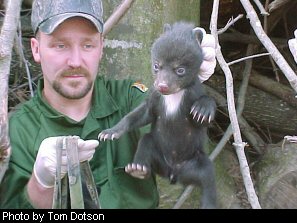

Close Encounters of a Bear KindBy Tom Dotson
In 1999, the West Virginia Division of Natural Resources Wildlife Resources Section initiated field studies to gather reproductive and survival data from the rapidly growing bear population in southern West Virginia. The primary study area included Boone, Fayette , Kanawha and Raleigh counties. An additional objective is to determine the status of bears captured as a result of nuisance activities. In the past, nuisance bears have been captured, tagged and released. Most were never encountered again. Bears are adaptable and will take advantage of almost every opportunity that involves food. Although rarely considered a danger to humans, bears occasionally kill livestock, have a sweet tooth, and will not turn down pastries or even fried chicken thrown out in the garbage. They also have a taste for sunflower seeds found in bird feeders and cannot seem to resist commercial beehives. On very rare occasions, they even break into houses and raid refrigerators. Currently, human-bear conflicts produce an average of 600 nuisance bear complaints annually to DNR personnel. Information obtained during the southern bear study helps biologists understand factors contributing to nuisance activities and enables them to develop techniques to discourage this undesirable behavior. Bears depend heavily on blackberries to replenish fat reserves lost during the preceding winter and to feed hungry cubs. The blackberry crop failed during 2001, however. As a result of this natural food shortage, DNR personnel received more than 1,000 complaints. Most of the complaints were bears getting into garbage. That year, 121 bears were captured in the southern bear study area. Of those, 65 were the result of nuisance complaints. Unfortunately, DNR personnel had to destroy nine of those bears because of their persistent, unacceptable behavior. One of our objectives is to develop hunting strategies that will encourage hunters to harvest nuisance animals; thus reducing the necessity for state-sponsored destructions . Since the southern bear study began, a total of 328 bears have been captured, representing 250 individuals. Radio transmitters have been placed on 69 bears. These radios enable biologists to monitor bear activity. Some radios are attached by a neck collar while others have been surgically implanted into the bear's abdominal cavity by a veterinarian. Reproductive data collected suggests that southern West Virginia bears produce more cubs (2.73 per litter) than those from the high mountain counties in the Monongahela National Forest (2.4 cubs per litter). Since the study began, 33 radioed sows have given birth to 90 cubs. Litter sizes ranged from 1 to 5. The most common litter size is three cubs. Sows have chosen a variety of locations in which to den: hollow trees, auger holes, under rocks, under piles of brush and logs, dugouts under rootballs of fallen trees, and simple depressions with little or no overhead cover. An examination of the causes of bear mortalities is another important part of the study. Hunting is the leading cause of mortality and the only effective method to control bear populations at socially acceptable levels. However, hunters harvested less than 10 percent of the tagged bears alive during the 2001 hunting season. Other important causes of death included destruction by DNR officials, illegal kills and road kills. Interestingly, the illegal mortalities were the result of nuisance activity where the humans on the receiving end of the nuisance behavior exhibited zero tolerance. Wildlife personnel will be gathering information about the southern bear population for another two years. Some of the preliminary results will change, but the rapid expansion of West Virginia's black bear population is expected to continue. There are limits to human tolerance of bears. We believe the knowledge gained will be critical to effective bear management and ensure that future generations of West Virginians will have an opportunity to know the joy of living in harmony with wild bears. Tom Dotson is a District Wildlife Biologist with the DNR. |
 Two decades ago, wildlife biologists reported fewer than 500 black bears in West Virginia. Most of them inhabited our eastern mountains in the Monongahela National Forest. Over the last ten years bear sightings have dramatically increased statewide. Once believed to be a creature of the wilderness, black bears now range into the high human population centers of Beckley, Charleston and Huntington. Bears will live anywhere we will let them. In fact, a bear rummaging through a garbage can for a midnight snack or just passing through metropolitan areas is now common.
Two decades ago, wildlife biologists reported fewer than 500 black bears in West Virginia. Most of them inhabited our eastern mountains in the Monongahela National Forest. Over the last ten years bear sightings have dramatically increased statewide. Once believed to be a creature of the wilderness, black bears now range into the high human population centers of Beckley, Charleston and Huntington. Bears will live anywhere we will let them. In fact, a bear rummaging through a garbage can for a midnight snack or just passing through metropolitan areas is now common.